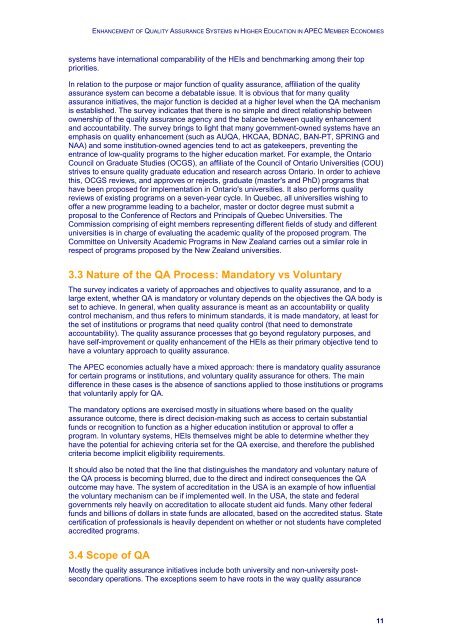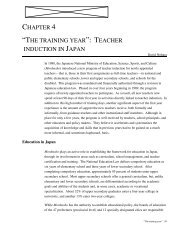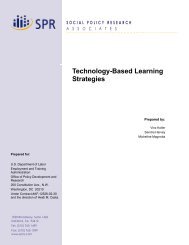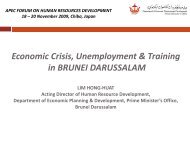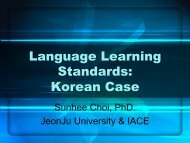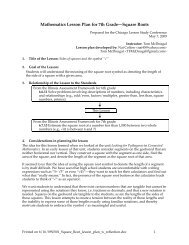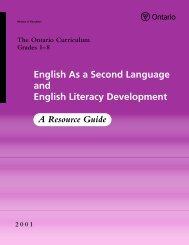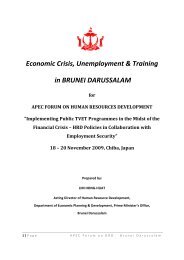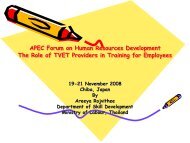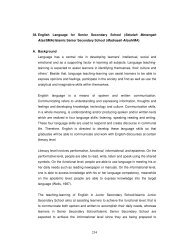Quality Assurance Systems in Asia-Pacific Economic Cooperation
Quality Assurance Systems in Asia-Pacific Economic Cooperation
Quality Assurance Systems in Asia-Pacific Economic Cooperation
Create successful ePaper yourself
Turn your PDF publications into a flip-book with our unique Google optimized e-Paper software.
ENHANCEMENT OF QUALITY ASSURANCE SYSTEMS IN HIGHER EDUCATION IN APEC MEMBER ECONOMIES<br />
systems have <strong>in</strong>ternational comparability of the HEIs and benchmark<strong>in</strong>g among their top<br />
priorities.<br />
In relation to the purpose or major function of quality assurance, affiliation of the quality<br />
assurance system can become a debatable issue. It is obvious that for many quality<br />
assurance <strong>in</strong>itiatives, the major function is decided at a higher level when the QA mechanism<br />
is established. The survey <strong>in</strong>dicates that there is no simple and direct relationship between<br />
ownership of the quality assurance agency and the balance between quality enhancement<br />
and accountability. The survey br<strong>in</strong>gs to light that many government-owned systems have an<br />
emphasis on quality enhancement (such as AUQA, HKCAA, BDNAC, BAN-PT, SPRING and<br />
NAA) and some <strong>in</strong>stitution-owned agencies tend to act as gatekeepers, prevent<strong>in</strong>g the<br />
entrance of low-quality programs to the higher education market. For example, the Ontario<br />
Council on Graduate Studies (OCGS), an affiliate of the Council of Ontario Universities (COU)<br />
strives to ensure quality graduate education and research across Ontario. In order to achieve<br />
this, OCGS reviews, and approves or rejects, graduate (master's and PhD) programs that<br />
have been proposed for implementation <strong>in</strong> Ontario's universities. It also performs quality<br />
reviews of exist<strong>in</strong>g programs on a seven-year cycle. In Quebec, all universities wish<strong>in</strong>g to<br />
offer a new programme lead<strong>in</strong>g to a bachelor, master or doctor degree must submit a<br />
proposal to the Conference of Rectors and Pr<strong>in</strong>cipals of Quebec Universities. The<br />
Commission compris<strong>in</strong>g of eight members represent<strong>in</strong>g different fields of study and different<br />
universities is <strong>in</strong> charge of evaluat<strong>in</strong>g the academic quality of the proposed program. The<br />
Committee on University Academic Programs <strong>in</strong> New Zealand carries out a similar role <strong>in</strong><br />
respect of programs proposed by the New Zealand universities.<br />
3.3 Nature of the QA Process: Mandatory vs Voluntary<br />
The survey <strong>in</strong>dicates a variety of approaches and objectives to quality assurance, and to a<br />
large extent, whether QA is mandatory or voluntary depends on the objectives the QA body is<br />
set to achieve. In general, when quality assurance is meant as an accountability or quality<br />
control mechanism, and thus refers to m<strong>in</strong>imum standards, it is made mandatory, at least for<br />
the set of <strong>in</strong>stitutions or programs that need quality control (that need to demonstrate<br />
accountability). The quality assurance processes that go beyond regulatory purposes, and<br />
have self-improvement or quality enhancement of the HEIs as their primary objective tend to<br />
have a voluntary approach to quality assurance.<br />
The APEC economies actually have a mixed approach: there is mandatory quality assurance<br />
for certa<strong>in</strong> programs or <strong>in</strong>stitutions, and voluntary quality assurance for others. The ma<strong>in</strong><br />
difference <strong>in</strong> these cases is the absence of sanctions applied to those <strong>in</strong>stitutions or programs<br />
that voluntarily apply for QA.<br />
The mandatory options are exercised mostly <strong>in</strong> situations where based on the quality<br />
assurance outcome, there is direct decision-mak<strong>in</strong>g such as access to certa<strong>in</strong> substantial<br />
funds or recognition to function as a higher education <strong>in</strong>stitution or approval to offer a<br />
program. In voluntary systems, HEIs themselves might be able to determ<strong>in</strong>e whether they<br />
have the potential for achiev<strong>in</strong>g criteria set for the QA exercise, and therefore the published<br />
criteria become implicit eligibility requirements.<br />
It should also be noted that the l<strong>in</strong>e that dist<strong>in</strong>guishes the mandatory and voluntary nature of<br />
the QA process is becom<strong>in</strong>g blurred, due to the direct and <strong>in</strong>direct consequences the QA<br />
outcome may have. The system of accreditation <strong>in</strong> the USA is an example of how <strong>in</strong>fluential<br />
the voluntary mechanism can be if implemented well. In the USA, the state and federal<br />
governments rely heavily on accreditation to allocate student aid funds. Many other federal<br />
funds and billions of dollars <strong>in</strong> state funds are allocated, based on the accredited status. State<br />
certification of professionals is heavily dependent on whether or not students have completed<br />
accredited programs.<br />
3.4 Scope of QA<br />
Mostly the quality assurance <strong>in</strong>itiatives <strong>in</strong>clude both university and non-university postsecondary<br />
operations. The exceptions seem to have roots <strong>in</strong> the way quality assurance<br />
11


